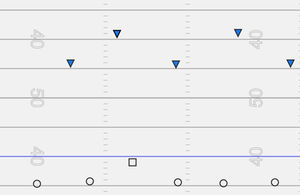Base Plays - The O'Brien Part 6
- Coach G
- Jan 18, 2020
- 4 min read
Updated: Feb 9, 2020
Each coach will have their own methodology for names of plays. For this blog, the backfield players are provided numbers based upon where they line up (Figure 1). The "1" back is often referred to as the QB by some; however, in this offense he may, or may not, be the principle passer as this might fall the the "2" back who is the featured running back in this formation. The "3" back is often referred to as the Fullback and he can either line up at the "3" or "4" position.

The holes are very straight forward as well. With the Center being 0 and each gap to the right of the center being every subsequent even number 2, 4 and 6 (see Figure 2). We also have a hole 9 to the weak side of the formation which is used for reverses.

*Note - we do not change the holes when we flip the formation. Thus, 26 (2 back through the 6 hole) is called the same whether the formation is Obrien left or right.
THE SWEEP
This is the bread and butter play and is the O'Brien's rendition of the standard student body right made famous by USC. The ball is snapped to the 1 who then pitches to the 2 who then proceeds through the 4 or 6 holes depending upon how the defense reacts post snap. The key is the block made on the LDE. In most instances, the LDE will be lined up outside the OR and when this happens we tend to block the LDE with the 3 back (figure 3). When this occurs the play will end up going through the 4 hole (as opposed to the 6 hole). If the LDE is aggressive and stunts at the snap, then this is countered by either the OR chucking him at the LOS before heading to block the LB (figure 4) or the OR making the block on the LDE while the 3 back takes the LB - which is actually Obrien 24 (figure 5). Another effective counter to an aggressive defense is to move the fullback to the 4 position giving him the ability to block the LDE at the LOS (figure 6).




The fullback is coached to either kick out the DE or to hook him inside. It does not make a difference. What is VERY important is that he makes this decision FAST. As the game develops, the fullback will get a feel for how soft or aggressive the DE is playing. The more aggressive the greater the opportunity to hook him and push him inside while the softer (more read and react) he plays the easier it is to kick him out and run inside of him.
The 1 back is instructed to make the pitch to the 2 back and read the block of the fullback. To do this effectively the pitch becomes a blind pitch to the 2 back through a series of repetitions in practice. The 1 back must get his eyes focused on the block as soon as possible and can not be spending any extra time watching where he pitches the ball. The down side to this is he will not see a fumble by the 2 back on a mishandled pitch. When practicing this play, if a 1 back takes the time to react to a mishandled snap he is immediately corrected for not getting his eyes up the field to make the block fast enough! The 1 back is better off acting as though he never saw the fumble than to assist the 2 back.
Now, here is the hardest part of this offense. It is not the moving snap, the blind pitch or the variable blocking schemes which change post snap. Those are all easy compared to what you have to teach the 2 back. He is told to run laterally until he gets the pitch and then follow the block of the 1 back. As simple as that seems it will blow the mind of a 12-18 year old male! If you get a dollar for every time the lead blocking 1 back goes through a hole untouched and the 2 back decides to go the opposite direction you will be able to retire years early and take up expensive past times.
The 2 back must start laterally to the LOS because this creates the necessary pitch relationship and it provides the timing necessary to read the block of the 1 back (given you can get the 2 back to read that block). The 2 back should reach the LOS almost arms length from the 1 back at the LOS and will cut off his block (figure 7).

The 2 backs block MUST be directional. We mean the block can not be parallel to the LOS. The 1 back's hips must face either sideline and when this block is made the 2 back is to cut the opposite direction of the block. We have a number of open field blocking drills we use which help us teach both the technical elements of the block along with the running backs cutting the correct direction.
.png)


























Comments